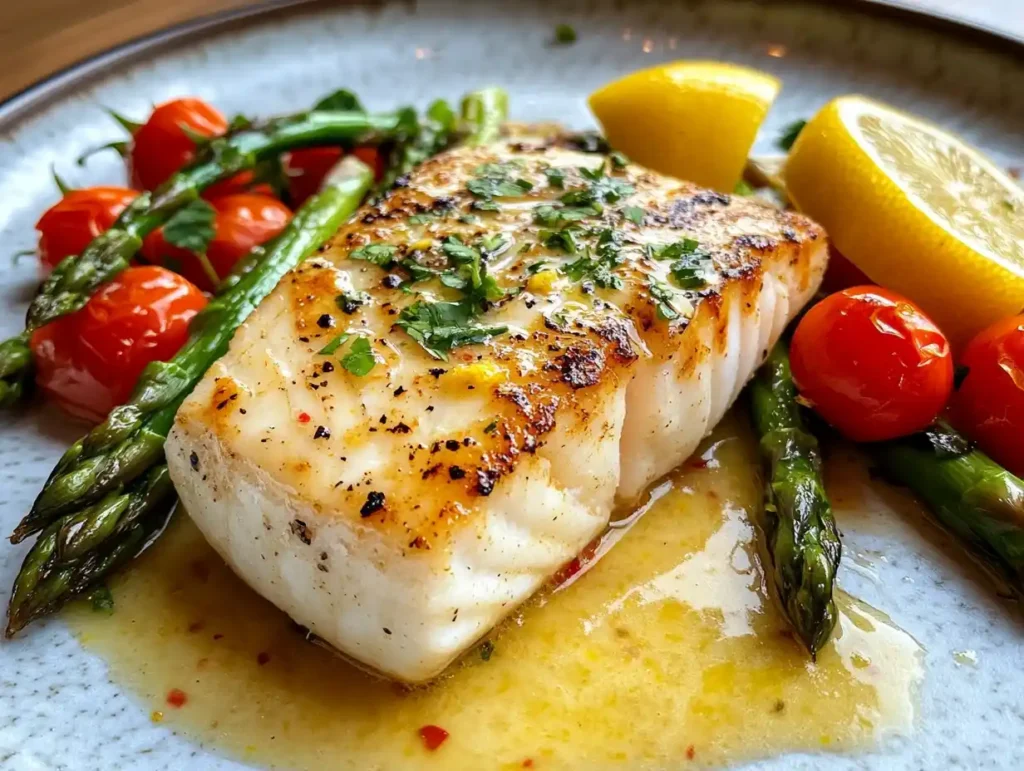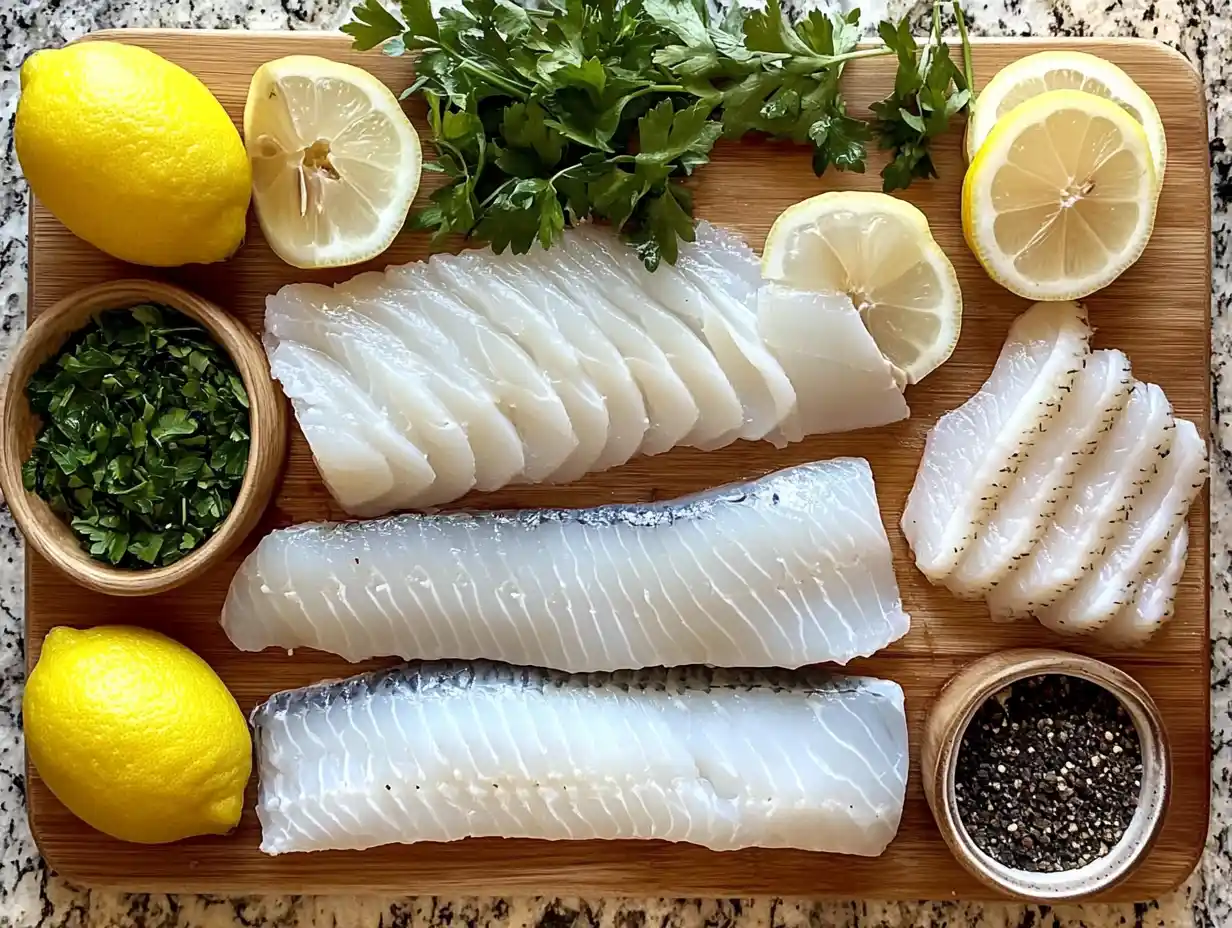Table of Contents
Introduction
What type of fish is white fish? The term refers to a variety of fish with light, flaky flesh and a mild taste. You can find these fish in both freshwater and saltwater habitats. White fish is famous for its versatility, making it a favorite in kitchens worldwide.
People love white fish because it’s healthy, easy to cook, and pairs well with many flavors. Whether you grill, fry, bake, or steam it, white fish fits seamlessly into countless recipes.
This article explores everything about white fish, including its types, uses, health benefits, and sustainability. Let’s get started!
What Defines White Fish?
White fish includes fish with lean, white flesh. Unlike oily fish like salmon, white fish contains less fat and has a milder flavor. Popular examples include cod, haddock, tilapia, and halibut.
Chefs and home cooks love white fish for its light texture and ability to absorb flavors. Its adaptable nature makes it ideal for various cuisines and cooking techniques.
Nutritional Value of White Fish
White fish is not only tasty but also packed with nutrients. It provides high-quality protein, essential for muscle growth and repair. Additionally, white fish is low in calories and fat, making it perfect for healthy meals.
It also delivers vitamins like B12 and minerals such as selenium, which help your body stay strong and energized. Some species, like halibut, even contain heart-healthy omega-3 fatty acids.
Types of White Fish: A Comprehensive Guide
White fish includes many species, each offering unique qualities. You can classify them into two main groups: freshwater and saltwater white fish. Both types are delicious and provide valuable nutrients.
Freshwater White Fish Species

Freshwater white fish live in lakes, rivers, and ponds. These species are mild in taste and work well in various recipes.
Common Varieties Found in Lakes
- Tilapia: This affordable and widely available fish has a neutral taste that suits many dishes.
- Whitefish: Known for its delicate texture, whitefish is a favorite for smoking or frying.
- Catfish: Often used in Southern cooking, catfish has a slightly sweet flavor and firm flesh.
Popular Choices for Cooking
Other freshwater options like perch and pike are excellent for grilling, stewing, or frying.
Saltwater White Fish Species
Saltwater white fish come from oceans and seas. They typically have firmer flesh, which makes them ideal for grilling and roasting.
Most Consumed Ocean White Fish
- Cod: Loved for its mild flavor, cod is perfect for dishes like fish and chips.
- Haddock: Slightly sweeter than cod, haddock works well for smoking or breaded recipes.
- Pollock: An economical choice, pollock is often used in fish sticks and seafood products.
Characteristics of Saltwater White Fish
Saltwater species tend to have a firmer texture and richer taste compared to freshwater fish. Varieties like halibut and flounder add a buttery flavor to meals, especially when baked or grilled.
Culinary Uses of White Fish

White fish is celebrated worldwide for its adaptability in the kitchen. Whether you’re a seasoned chef or a home cook, this versatile protein can be transformed into a wide range of delicious dishes. Its mild flavor serves as a blank canvas, absorbing spices, marinades, and sauces beautifully.
White Fish in Global Cuisine
Europe
In European cuisines, white fish is a staple ingredient.
- England: Haddock or cod is a key component of the classic fish and chips, often battered and deep-fried.
- Spain: Bacalao, or salted cod, is a traditional ingredient in tapas and stews like Bacalao a la Vizcaína.
- France: White fish such as sole or halibut is often poached and served with creamy sauces like beurre blanc.
Asia
Asian recipes showcase the delicate flavors of white fish with a variety of cooking techniques.
- Japan: White fish is often used for sushi and sashimi, prized for its clean taste and texture.
- India: Curry dishes like fish masala frequently feature freshwater white fish like tilapia.
- China: Steamed white fish, flavored with ginger, soy sauce, and scallions, is a classic dish.
North and South America
- United States: Catfish is popular in Southern cooking, often breaded and fried. Cod and haddock are staples in seafood chowders.
- Peru: Ceviche, a refreshing dish of marinated raw fish, often uses white fish like tilapia or sea bass.
Popular Recipes and Preparation Methods
Grilling and Roasting
Firm white fish such as halibut or sea bass holds up well on the grill or in the oven. Pair it with lemon, herbs, and a drizzle of olive oil for a healthy, flavorful meal.
Frying
Fried white fish is a classic comfort food, from crispy fish tacos to golden fish sticks. Cod and haddock are common choices for these recipes.
Steaming and Poaching
Delicate species like sole or flounder are perfect for steaming or poaching. These methods preserve the fish’s natural flavor and moisture while keeping it low-calorie.
Flavor Profiles of White Fish
Comparison to Other Types of Fish
White fish stands out for its mild and slightly sweet flavor, making it less “fishy” than oily fish like salmon or mackerel. Its lightness pairs well with a variety of seasonings and cooking techniques, offering flexibility not found in stronger-tasting fish.
Health Benefits of Including White Fish in Your Diet
Incorporating white fish into your diet is not only delicious but also incredibly nutritious. Its low-fat content, rich protein profile, and abundance of essential nutrients make it a valuable addition to a balanced diet. Let’s explore the health benefits in detail.
Low-Calorie Protein Source
White fish is an excellent source of lean protein, essential for muscle repair, growth, and overall body function. Unlike fattier fish, it provides high-quality protein with fewer calories, making it ideal for weight management and maintaining muscle mass.
Protein Comparison
- Cod (100g): Approximately 18g of protein and only 82 calories.
- Haddock (100g): Roughly 20g of protein and around 90 calories.
These values highlight why white fish is often recommended for fitness enthusiasts and those on calorie-restricted diets.
Vitamins and Minerals Found in White Fish
White fish is a powerhouse of essential vitamins and minerals, many of which support vital bodily functions.
Vitamin B12
- Crucial for red blood cell production and maintaining healthy nerve function.
- Found in abundance in species like cod and haddock.
Selenium
- A powerful antioxidant that boosts immune health and supports thyroid function.
- White fish like halibut is a rich source of selenium.
Phosphorus
- Important for healthy bones and teeth, as well as energy production.
- White fish species provide a significant amount of daily phosphorus needs.
Omega-3 Fatty Acid Content
While not as high in omega-3 fatty acids as oily fish, white fish still contains these heart-healthy fats in moderate amounts. Omega-3s are known to:
- Reduce inflammation in the body.
- Support cardiovascular health by lowering triglyceride levels.
- Improve brain function and mood regulation.
Species like halibut and sea bass contain higher amounts of omega-3s among white fish varieties.
Additional Benefits
- Low Cholesterol: White fish is a heart-friendly choice for those watching their cholesterol levels.
- Digestibility: Its light, tender flesh makes it easy to digest, making it suitable for people with sensitive stomachs.
- Allergen-Friendly Options: Many white fish varieties are hypoallergenic and pose a lower risk of triggering seafood allergies compared to shellfish.
Environmental and Sustainability Considerations for White Fish
As global demand for seafood grows, understanding the environmental impact of white fish consumption is crucial. Responsible sourcing and awareness of sustainability practices can help protect marine and freshwater ecosystems.
Overfishing Concerns
Overfishing has significantly impacted many white fish populations. Popular species like cod and haddock have seen their numbers dwindle due to unsustainable fishing practices. Overfishing disrupts the ecological balance, affecting marine biodiversity and depleting resources for future generations.
Species at Risk
- Atlantic Cod: A historically abundant species, now heavily regulated due to overfishing.
- Halibut: Slow-growing and long-lived, making it particularly vulnerable to overharvesting.
Steps to Mitigate Overfishing
- Supporting fisheries certified by organizations like the Marine Stewardship Council (MSC).
- Choosing underutilized species to reduce pressure on popular fish stocks.
- Advocating for government policies that enforce sustainable fishing quotas.
Best Practices for Responsible Sourcing
Consumers play a vital role in supporting sustainable seafood practices.
Eco-Friendly Labels
Look for certifications such as:
- MSC Blue Label: Indicates the fish was caught using sustainable methods.
- Aquaculture Stewardship Council (ASC): Certifies responsibly farmed fish.
Seasonal Choices
Eating fish during their peak seasons ensures that populations have had time to reproduce and replenish. Local fishmongers and sustainability guides can help identify the best options.
Farmed vs. Wild-Caught White Fish
The debate between farmed and wild-caught fish continues, with pros and cons to each option.
Farmed White Fish
- Pros:
- Consistent availability.
- Reduces pressure on wild populations.
- Controlled conditions often prevent overfishing.
- Cons:
- Potential for environmental pollution from fish farms.
- Some farmed fish may have lower nutritional value.
Wild-Caught White Fish
- Pros:
- Natural diet leads to superior taste and nutrient profiles.
- Supports traditional fishing communities.
- Cons:
- Often more expensive.
- Risks of overfishing if not responsibly managed.
Innovative Solutions
- Aquaponics: Combining fish farming with hydroponic plant growth to create a closed-loop system.
- Bycatch Reduction Devices: Tools that minimize the accidental capture of non-target species.
FAQs About White Fish
When it comes to white fish, there are often questions about its types, preparation, and health considerations. Here are some of the most commonly asked questions, along with detailed answers to help you make informed choices.
Is White Fish the Same as Cod?
Not exactly. Cod is a type of white fish, but the term “white fish” is much broader. It includes a variety of species such as haddock, tilapia, halibut, and pollock. White fish generally refers to fish with lean, white, and flaky flesh, which cod certainly qualifies as, but it’s not the only example.
Can White Fish Be Eaten Raw?
Yes, some white fish species can be eaten raw, but only if they are sushi-grade or specifically labeled safe for raw consumption.
- Examples of suitable white fish: Sea bass and flounder are often used in sushi and sashimi.
- Caution: Always ensure the fish is fresh and from a trusted source to avoid foodborne illnesses like parasites.
Which White Fish Is Best for Frying?
Cod and haddock are among the best choices for frying due to their firm texture and mild flavor. They hold up well during the cooking process, making them ideal for dishes like:
- Fish and chips.
- Fried fish tacos.
For a Southern twist, catfish is a popular choice, often coated in cornmeal before frying.
How Can I Identify Fresh White Fish?
To ensure you’re buying fresh white fish, look for these signs:
- Appearance: The flesh should be moist, shiny, and free of discoloration.
- Smell: It should have a clean, ocean-like smell, not a strong fishy odor.
- Texture: Fresh fish should feel firm to the touch, not mushy.
- Eyes and Gills: If the fish is whole, clear eyes and bright red gills are indicators of freshness.
Are There Allergies Linked to White Fish?
Yes, fish allergies are common and can include white fish species. Symptoms may include hives, swelling, or digestive issues, and in severe cases, anaphylaxis. Individuals with known fish allergies should consult their doctor before consuming white fish.
Related Articles About White Fish
Enhance your article on “What Type of Fish Is White Fish?” by linking to these informative posts:
- Explore the nutritional benefits and versatility of white fish in White Fish: The Ultimate Guide to Its Benefits and Uses.
- Learn about the healthiest and tastiest options for white fish in What Is the Best White Fish to Eat? Delicious and Healthy Choices.
- Discover whether white fish is a good addition to your diet in Is White Fish Good to Eat? Benefits, Risks, and Recipes.
These internal links provide readers with additional insights and resources about white fish.
Conclusion
White fish, with its mild flavor, versatility, and numerous health benefits, has earned its place as a staple in cuisines worldwide. From freshwater species like tilapia and perch to saltwater favorites such as cod and haddock, white fish offers a diverse array of options for cooking and dining. Its high protein content, low fat, and rich nutritional profile make it a fantastic choice for anyone looking to maintain a healthy diet.
Understanding the environmental impact and prioritizing sustainable practices are essential for ensuring that future generations can enjoy this valuable resource. By making informed choices—whether selecting farmed or wild-caught fish, checking for sustainability certifications, or experimenting with global recipes—you can enjoy white fish in a way that is both delicious and eco-conscious.
So next time you’re planning a meal, consider the many varieties of white fish and the creative ways they can be incorporated into your diet. Whether grilled, fried, or served raw, white fish is a versatile, nutritious option that satisfies both the palate and the planet.
